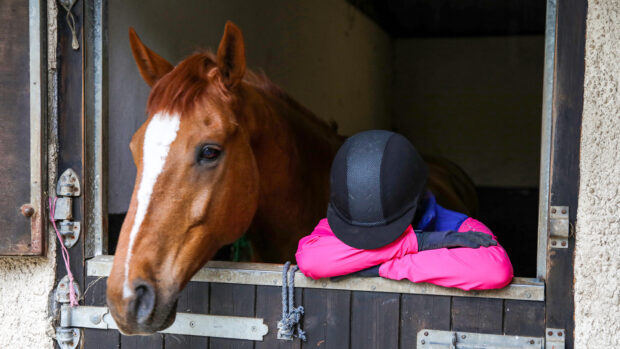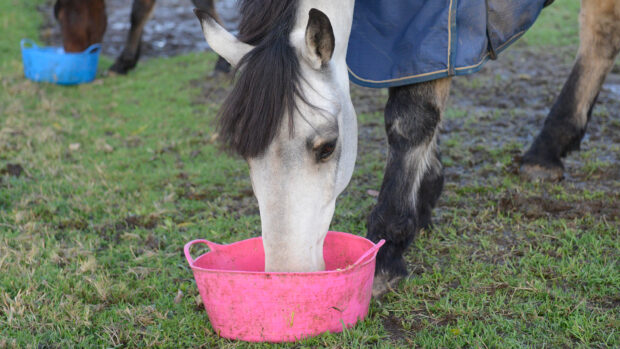Feed balancers are something most horse owners have come across, but do you know what purpose balancers serve? Many owners have fed balancers to their horses, trying to resolve a dietary issue – or because it just seemed like a good idea – but without really understanding what they are and what they do. In order to find out, we approached several equine nutritionists and asked them to explain the mystifying balancer.
Clare Barfoot (RNutr), the senior marketing, research and development director at Spillers, says: “A well-designed balancer provides ideal levels of vital vitamins, mineral and amino acids to balance the base diet with minimal calories and starch. Typically, balancers come in pellet form and are fed at lower levels than traditional compound feeds; 500g (a couple of mugfuls) per day for a 500kg horse. The low calorie content makes balancers an especially good choice for horses and ponies that maintain their weight on a forage-only diet or for those that require less than the recommended amount of compound feed.
“Every horse needs a balanced diet. While grass alone may provide up to three times the horse’s daily energy (calorie) requirements, certain nutrients such as lysine, copper, zinc and selenium are typically low in UK pasture. Vitamin E is the most important antioxidant and although grass alone may meet maintenance requirements, levels in in hay and haylage may be negligible.”
Lizzie Drury, the senior nutritionist at Saracen, explains: “Thousands of horses and ponies survive on just grazing alone; their coats may not shine, and their feet may not be in the best condition, but they are generally happy and healthy. How many of us feed mainly forage with just a handful of a coarse mix or cube ‘just for the vitamins and minerals?’ How many of us feed every supplement under the sun except one with vitamins and minerals? Feed balancers, as the name suggests are designed to balance a horse or pony’s ration nutritionally in terms of vitamins and minerals, protein and energy as a result of increased emphasis on forage utilisation in the diet.”
Katie Grimwood, BSc (Hons), nutrition advisor for Bailey’s, elaborates: “Balancers are a really useful way of giving your horse all the nutrients he needs without supplying any additional calories, so are perfect for good-doers or those who maintain condition well on forage alone. A balancer will provide all the essential nutrients you’d find in a mix or cube, without the associated energy or calorie element. Because they are so nutrient-dense, they can be fed in much smaller quantities. They can be fed as the sole concentrate, or mixed with a little chaff or beet for good doers, or they can be used to “top dress” a fortified mix or cube if less than recommended quantities are being fed.”
She further explains: “Balancers contain a wide range of vitamins and minerals in carefully calculated ratios to provide a balance of these nutrients to meet a horse’s daily needs. The basics should all be there, whichever balancer you choose; nutrients to support healthy hoof growth, metabolism, tissue repair – all the body processes which are involved in keeping a horse healthy.
“They also contain quality protein, supplying amino acids, the building blocks of all body tissues, including horn, hair, muscle and bone, so pretty important and often deficient in modern forages. Most balancers also contain one or more “digestive enhancers”, like a yeast culture or prebiotic, which help support gut efficiency.”
A horse is designed to eat grass, and it might seem surprising that it would not be getting sufficient vitamins and minerals from that grass. So why does a horse at pasture need a balancer? Wild or feral horses travel great distances, grazing on a wide variety of vegetation and in a range of locations, but domestic horses more or less stay in one place, and they get fed hay and whatever concentrated feed their owners provide.
Kate Hore, RNutr (Animal), the registered nutritionist with NAF, elucidates: “Termed ‘micronutrients’ many of them may be deficient in the general diet, either due to soil and grazing deficiencies which are passed to pasture and forage, or micronutrient losses particularly in preserved forage and feed.”
Of course, many horses appear perfectly healthy on a diet of grass and hay, but Barfoot suggests that a balancer can still benefit them. “Initially horses may look fine when not being provided with a balanced diet, but the long-term effects may include poor hoof growth and condition, a compromised immune system and a lack of general wellbeing,” she says. “A balancer, with just 20% of the calories of the recommended daily amount of horse and pony cubes, can be used safely for horses and ponies on restricted diets including those prone to laminitis.”
Making a similar point, Grimwood says: “You are unlikely to see weight gain when adding a balancer, because they do not contain significant calorie levels, but an overall improvement in muscle tone may be seen if the previous diet was deficient. Furthermore, the yeast and prebiotics that balancers contain, and which help improve gut efficiency, should mean that your horse is able to extract more from the forage and other elements of his diet.”
Other benefits, according to Grimwood, include “an increased enthusiasm for work. Horses who are not getting enough vitamins and minerals often feel lacklustre and lazy but, once getting the nutrients they need, their metabolism improves, and they feel a whole lot better. Improving gut health, through the inclusion of digestive enhancers (yeast, MOS, ScFOS), can also make a horse feel more comfortable in himself and therefore less crabby or jumpy.”
Balancers work their best when the horse receives the right balancer for its workload, age, and metabolism. Hore advises: “Well-designed balancers truly ‘balance’ the diet, i.e. feeding more of those nutrients that are likely to be low, such as selenium and zinc, and less of those well provided naturally. Therefore, we don’t advise balancers and supplements that promise to provide ‘100% RDA’ for all micronutrients – after all, they are not truly balancing, as they are not considering what is provided by the rest of the diet.”
Most feed companies have helplines, so if you feel that a feed balancer might be suitable for your horse, you can contact one and speak to a nutritionist.
You may also be interested in…

Feed balancers: what’s on the market?

How are feed balancers different to vitamin and mineral supplements?

How to choose the right feed balancer for your horse

Subscribe to Horse & Hound magazine today – and enjoy unlimited website access all year round
Horse & Hound magazine, out every Thursday, is packed with all the latest news and reports, as well as interviews, specials, nostalgia, vet and training advice. Find how you can enjoy the magazine delivered to your door every week, plus options to upgrade your subscription to access our online service that brings you breaking news and reports as well as other benefits.




